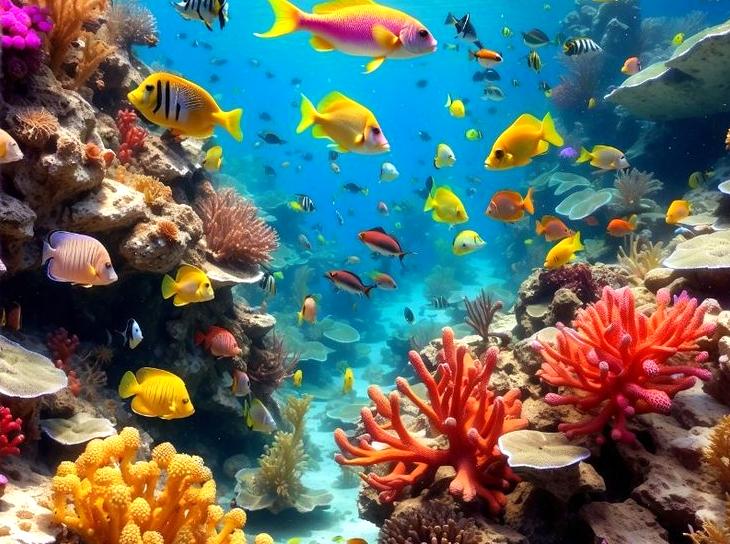
The Coral Sea Shelf is a vital ecological zone that plays an essential role in maintaining marine biodiversity and supporting various marine life forms. Spanning the northeastern coast of Australia, this continental shelf is characterized by its vibrant coral reefs, stunning marine habitats, and diverse species that thrive in its waters. Understanding the significance of the Coral Sea Shelf goes beyond just appreciating its beauty; it involves recognizing its critical role in global ecological health and its challenges in the face of human activity. In this article, we will delve into the unique characteristics of the Coral Sea Shelf, its ecological importance, threats, and conservation efforts.
Characteristics of the Coral Sea Shelf
The Coral Sea Shelf features a diverse array of marine environments, including coral reefs, sandy seabeds, and sea grass meadows, all of which contribute to its ecological richness. Stretching approximately 700 km from the Great Barrier Reef towards New Caledonia, the shelf supports numerous ecosystems that host various marine life. The vibrant coral reefs serve as essential habitats for fish, mollusks, and crustaceans, while the sea grass beds provide spawning grounds and nurseries for young fish. The unique geological formations found on the shelf, including underwater mountains and ridges, create microhabitats that promote biodiversity. Additionally, the shelf’s waters are warm and nutrient-rich, further enhancing the potential for varied marine life. Its position in the South Pacific Ocean allows it to receive influences from different ocean currents, making it a dynamic and thriving environment.

Ecological Importance
The Coral Sea Shelf is vital not just for the marine species that inhabit it, but also for human populations that depend on its resources. It supports commercial fisheries, providing a livelihood for many communities along the Australian coast. The shelf is home to a wealth of marine species, including a variety of fish, seabirds, and marine mammals. In particular, the coral reefs serve as critical breeding grounds, playing a significant role in the reproductive cycles of many sea creatures. The ecosystem also contributes to global carbon cycles, as healthy coral reefs absorb carbon dioxide and help mitigate climate change. Furthermore, the Coral Sea Shelf enhances ecosystem resilience, enabling marine life to adapt to changing environmental conditions. The presence of diverse species ensures that the ecosystem remains balanced and capable of enduring shifts brought on by both natural processes and human impact.

Threats to the Coral Sea Shelf
Despite its ecological importance, the Coral Sea Shelf faces numerous threats that jeopardize its health and sustainability. Climate change poses a significant risk, leading to coral bleaching and altered ocean chemistry, which can severely affect marine biodiversity. Overfishing and unsustainable fishing practices are also detrimental, diminishing fish populations and degrading the marine ecosystem. Pollution from land-based sources, including runoff containing chemicals and plastics, negatively impacts water quality and marine life. Moreover, increasing maritime traffic and potential oil exploration raise concerns about oil spills and habitat destruction. Additionally, invasive species can disrupt the ecological balance, outcompeting native species and altering habitats. To preserve the Coral Sea Shelf, awareness and proactive measures are essential to mitigate these threats and protect its unique marine environments.
Conservation Efforts
Recognizing the importance of the Coral Sea Shelf has led to various conservation efforts aimed at safeguarding its biodiversity and ecological integrity. Protected marine reserves have been established to create safe havens for wildlife, allowing ecosystems to regenerate while prohibiting destructive activities like overfishing and mining. Organizations and governments are increasingly working together to conduct research and monitor the health of marine ecosystems, aiming to address the impacts of climate change and human activity effectively. Community-based initiatives encourage local populations to engage in sustainable fishing practices and become stewards of their marine environment. Education and outreach programs play a vital role in raising awareness about the significance of preserving marine ecosystems and fostering responsible tourism. Through these combined efforts, stakeholders are striving to ensure the Coral Sea Shelf remains a vibrant and thriving part of the global marine landscape.

Conclusion
The Coral Sea Shelf is an ecological treasure that hosts immense biodiversity and is crucial for the health of the marine environment. Its vibrant coral reefs and diverse marine life contribute not only to local economies but also to the global ecosystem. However, ongoing threats from climate change, pollution, and unsustainable practices necessitate immediate action and cooperation among stakeholders to preserve this valuable habitat. By promoting conservation efforts and adopting sustainable practices, we can ensure that the Coral Sea Shelf remains a thriving marine environment for generations to come.
FAQs
The Coral Sea Shelf is a shallow marine area located off the northeastern coast of Australia, characterized by diverse ecosystems including coral reefs, sea grass beds, and sandy seabeds.
2. Why is the Coral Sea Shelf important?
The Coral Sea Shelf is vital for marine biodiversity, supporting numerous species and contributing to local economies through fishing and tourism, as well as playing a role in global ecological health.
3. What are the major threats to the Coral Sea Shelf?
Major threats include climate change, overfishing, pollution from land-based sources, invasive species, and increased maritime traffic, all of which impact the health and sustainability of the marine ecosystem.
4. What conservation efforts are in place for the Coral Sea Shelf?
Conservation efforts include the establishment of protected marine reserves, research initiatives, community-based sustainable practices, and educational outreach programs aimed at raising awareness and promoting stewardship.
5. How can individuals help protect the Coral Sea Shelf?
Individuals can help protect the Coral Sea Shelf by practicing sustainable fishing, reducing plastic use, supporting conservation organizations, and participating in beach clean-up efforts, thereby fostering awareness and responsible behavior.
